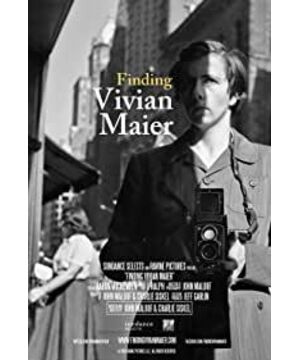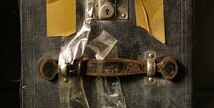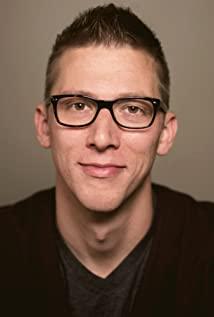Based on such a legendary character story, as eye-catching as the eccentric genius painter in "The Moon and Sixpence," "Finding Vivienne Meyer," nominated for the 87th Academy Award for Best Documentary Feature, opens with a few A simple word description of Vivienne, from nine people she's been with, paradoxical, eccentric, privacy-conscious. Vivienne was able to appear in the public eye because of an auction. In 2007, john maloof was writing a book about history, so he bought a box of negatives for $380 at the auction house across the street. Looking for Chicago's video data, what is unusual is that the photographer who googled this box of negatives found nothing. Out of his love for these works, john scanned it and uploaded it on ficker, which really attracted a lot of people's attention, and then he wanted to go further. Contacting the museum to get help to develop all the photos was rejected, but unexpectedly, Vivian's works were exhibited in a gallery and caused a sensation. Since then, Vivian became famous, and john also started a journey to find Vivian.
John visited the family where Vivian had worked according to the bill address, but no one had a deep relationship with him. Vivian and her focus on personal privacy, not allowing anyone to join her room, and carrying several large suitcases at any time , collecting the fragments and details of life. This is the audience's first impression of Vivian, and then there will be deep excavations about the characters. Full of whimsy, she once let the child she was looking after lay motionless on the road until an ambulance was finally called in. It was an accident planned to film people's performance, and the content of the filming was also wonderful and interesting. In addition, she has made a movie called "1972 Chicago Mother and Child Murder". The theme of this film is to seek as a clue, and the focus is on Vivian's life. The creative thoughts and process are only scratches of the surface. At the same time, there are not many photographic works in the film, which makes the film lose a certain amount of information. It has gained a degree of watchability and attracted the attention of the audience with a suspenseful story.
If that's all, she's just a talented female photographer who throws a point of suspense in the third third of the film, she uses a French accent to make everyone think he's French, when in fact her accent is exactly In disguise, she was born in the United States, New York. The point of conflict is that if Vivienne is an incognito, extremely talented person who is unwilling to share with others, trying to take all the works of art she has created for herself, then out of respect for the personal wishes of the deceased, Everything john did was unethical, digging out the privacy that others didn't want to disclose to the public.
Later, it was further discovered that it was not only Vivian, her parents and relatives seldom showed contact with relatives, just like a mysterious family tradition, which gave Vivian a mysterious veil. Vivian's mother is French, so she found a small village in France. What is surprising is that her mother also loves photography. Everything seems to have an explanation. Her talent and sense of distance may originate from childhood. educational experience. Knowing Vivienne's background allows us to speculate on the causes of her character, and paradoxically illuminates her mysteries and achievements. Returning to the real time and space, John's work has made further progress. The processing of the posthumous works is handed over to a company. The two time and space are intertwined, which reduces the cumbersome feeling of narrating completely in chronological order, and explains the later whereabouts of these works. Did it get any attention.
Then Vivian's creation is still bold and unscrupulous, she shoots at will, regardless of the willingness of the subject or the danger of the surrounding environment. At this point, more than halfway through the film, it focuses on describing the other side of Vivienne: she likes strange and discordant events, such as murder, rape, molestation, etc. This echoes the previous films made by Vivian, and now it is told in a more direct and explicit way, indicating that it is beginning to dig deeper into Vivian's inner world. What's more, Vivian will be angry and even beat children, and suffer from severe cleanliness and obsessive-compulsive disorder, resulting in extreme behavior. The other side of genius is a lunatic. This sentence has been corroborated by Vivian. The potential spiritual distortion is manifested here. After foreshadowing here, the more serious abnormal behavior in later life is logical. Once again, she unexpectedly started a round-the-world trip, covering Egypt, Hong Kong, Singapore, South American countries, etc., and left more than a thousand photos. She once said that she was a spy. In fact, he was right. He is a whole-hearted and unscrupulous observer and recorder, faithfully recording all kinds of human group portraits. This feat interspersed here produces a clear contrast effect, and the conflict and tension are more clearly expressed.
She lives in the attic and prohibits anyone from approaching, and she almost obsessively collects newspapers and piles them up in the room, so that she can't move an inch in the room, and the attic begins to collapse and tilt. She could find that, at one point, she suspected that someone was watching her with a telescope. Although Vivian did not give up photography at this time, she could see that her mental condition was getting worse and worse. What kind of suffering, the film also took a stroke. In her later years, she became more withdrawn and eccentric, and her abnormal behavior made people afraid to approach her. Her life's end was even more embarrassing and stumbled to the side of the road. At this point, john found Vivienne, her life experience has come to an end, and at the end point to artistic achievements and the love and pursuit of photography, summarizing the past and reality re-integrated, ending the film in the photo development room, development is both a film The ending is the end of the formation of a photo, and it also means that from the discovery of the negative to the development of the film, john made this romance a happy ending.
A recurring self-portrait of Vivian in the film is her bust, with her face and body on one side of the dark side and exposed to the light, just as others have said of him, paradoxical, gifted On the other hand, he is obsessed with violence and even beating children. On the other hand, he is never married and has no children. On the other hand, he is a nanny who raises anyone's children. He lives in Chicago and travels around the world for eight months.
The themes in the two films are roughly the same. They are both introductions to the legendary life of Vivienne Maier, and a retelling of the hidden genius legends that are beyond the reach of ordinary people. The reason why genius stories attract attention is because there are real ones. Originating from life, everyone wants to have a genius mind but cannot stand the loneliness that goes with them. Many geniuses are mysterious and end up in a bad way, destroying beautiful things for others to see, and the tragic effect is obvious. As well as Vivian's extremely sensitive photographic nerve, humorous expression, combined with the profound connotation of political current affairs and feminism, it is a praise for the pursuit of art fanaticism. In addition to the stunning photo material, Vivian's works have ideas to express, which are intriguing and worth thinking about. The double story tells that people who are attracted by photo works will naturally become interested in understanding the photographer.
The BBC version focuses more on the creation of the work itself, without deliberately digging into Vivian's personal character, but after a general introduction, it focuses on how a person who is obsessed with art realizes his artistic aspirations, and reveals the secret behind the genius of photography itself. At the same time, more photo works are added to enrich the visual perception and have the value of precious documents. "Finding Vivienne Maier" takes John's seeker as a clue, leading the audience to gradually uncover their doubts, step by step to understand the real and comprehensive Vivian, like the suspenseful version of the biography, which is new in structure. Change the status of the audience from an audience to a seeker in it.
In terms of structure and technique, "Finding Vivienne Meyer" is guided by John's perspective, logically based on the results obtained by exploring Vivienne, and narrated in the order of Vivienne's juvenile, middle-aged and old age, accompanied by a time-space cross narrative in the middle. (John made Vivian's work famous and john tried to investigate Vivian's life two clues). The forms of expression include John's monologue and the reenactment of the investigation scene, the display of Vivian's video works, and the interviews with different insiders (appearing in different periods in Vivian's life), which are more abundant. Some of the film methods used to enhance the viewing interest are not demanding of documentary methods, and the main purpose is to understand and resonate with the audience. As for "Vivian Maier: Who Moved the Nanny's Photo", as an official production, it has stronger educational significance and a clear and organized structure. While introducing Vivian in a brief and appropriate manner, it carefully analyzes each of Vivian's works. The scene during the shooting is closer to the talented Vivian in the creation.
View more about Finding Vivian Maier reviews








